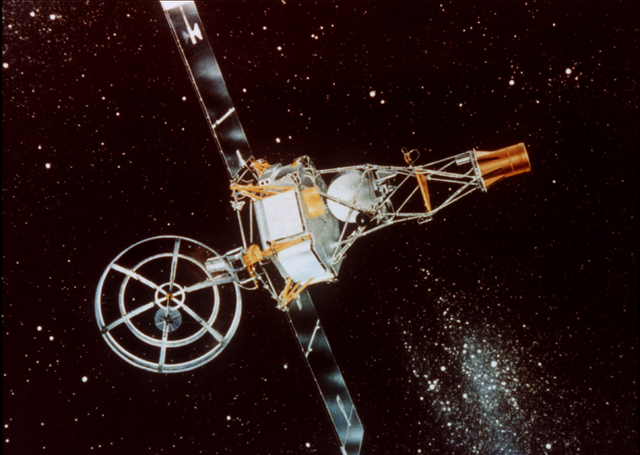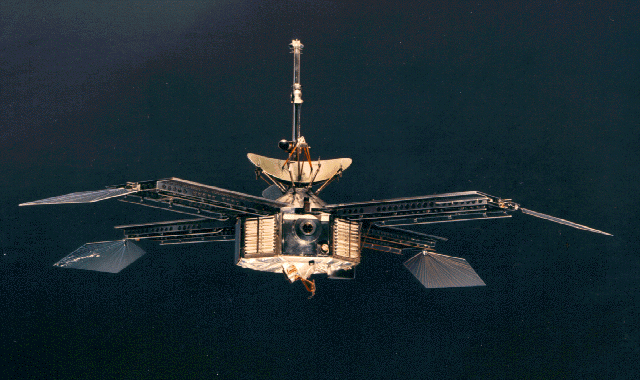You are using an out of date browser. It may not display this or other websites correctly.
You should upgrade or use an alternative browser.
You should upgrade or use an alternative browser.
Star Trek...meets...The Mariner Probes
- Thread starter steve samurai jack
- Start date
steve samurai jack
Well-Known Member
Well, you wanted it, so here is my little thread dedicated to the first probes to explore the other planets... the Mariners.
Let's start at the beginning.
The year is 1962. The United States has finally caught up to the Soviet Union in the Space Race, and now seeks to overtake it, with a bold new project - the Mariner Program. This program would send robotic probes to the other planets of the Inner Solar System (Mercury, Venus, and Mars), and truly usher in the Interplanetary Age. However, there were still problems to overcome. The Soviets had previously tried to send two probes to Venus - Sputnik 7 and Venera 1 - and both of those had failed. Sputnik 7 was destroyed when its rocket exploded on the launch pad, and while Venera 1 HAD made it into space, it had also shut down only about a week into its mission. And the actual Mariner design wasn't far enough along to send a "true" Mariner-class probe into space yet. But, when things aren't quite going according to plan, what do you do? Improvise....
MARINERS 1 & 2

Now, while the "true" Mariner design wasn't far enough along, NASA DID have a few surplus Ranger-class lunar probes hanging around. Collectively shrugging, they took two of them, and renamed them Mariner 1 and Mariner 2. And since they wanted to first make sure they could get to another planet, they chose Venus - the closest planet to Earth - as the target for the first two Mariner probes. And on July 22nd, 1962, Mariner 1 blasted off from Cape Canaveral to begin a three-month-long journey to Venus.
Only there was a problem. A software glitch had caused the rocket carrying Mariner 1 to start fishtailing, and it veered dangerously off-course. In response, the Range Safety Officer was forced to give the rocket the auto-destruct command, vaporizing the rocket and Mariner 1 with it.
Identifying and correcting the problem which had caused the loss of Mariner 1, NASA readied Mariner 2 for lift-off. And on August 27 - just over a month after the Mariner 1 fiasco - Mariner 2 blasted off from Cape Canaveral. This time, it made it into space, and successfully left Earth's orbit, beginning the three-month-long journey to the second planet.
Mariner 2 was, perhaps unsurprisingly, a troublesome space-craft. It was being sent on a mission for which it was never designed, after all. The Earth-tracker had come close to failure, only to jump back to full strength a few days before it would have been too late. Several telemetry sensors failed. One of the solar panels stopped working (though, considering that Venus is much closer to the sun, the other solar panel was able to power the probe sufficiently). It was, however, able to make the journey to Venus. On December 14, 1962, Mariner 2 flew by Venus, coming within roughly 20,000 miles of the planet. It took readings of Venus' clouds and surface, revealing that Venus was a hellishly hot world with a choking atmosphere. Any hopes of finding Venusians were forever dashed.
When news of Mariner 2's flyby was brought to the American public, they were ecstatic - for the first time, we'd beaten the Soviets at something in the Space Race, and had proven that we were DONE playing catch-up. This was the turning point in the Space Race. To commemorate this occasion, William Pickering - the head of the Jet Propulsion Laboratory - was named Grand Marshall of the 1963 Tournament of Roses Parade, and a float of Mariner 2 was made - it even being the Parade's leading float.

Let's start at the beginning.
The year is 1962. The United States has finally caught up to the Soviet Union in the Space Race, and now seeks to overtake it, with a bold new project - the Mariner Program. This program would send robotic probes to the other planets of the Inner Solar System (Mercury, Venus, and Mars), and truly usher in the Interplanetary Age. However, there were still problems to overcome. The Soviets had previously tried to send two probes to Venus - Sputnik 7 and Venera 1 - and both of those had failed. Sputnik 7 was destroyed when its rocket exploded on the launch pad, and while Venera 1 HAD made it into space, it had also shut down only about a week into its mission. And the actual Mariner design wasn't far enough along to send a "true" Mariner-class probe into space yet. But, when things aren't quite going according to plan, what do you do? Improvise....
MARINERS 1 & 2

Now, while the "true" Mariner design wasn't far enough along, NASA DID have a few surplus Ranger-class lunar probes hanging around. Collectively shrugging, they took two of them, and renamed them Mariner 1 and Mariner 2. And since they wanted to first make sure they could get to another planet, they chose Venus - the closest planet to Earth - as the target for the first two Mariner probes. And on July 22nd, 1962, Mariner 1 blasted off from Cape Canaveral to begin a three-month-long journey to Venus.
Only there was a problem. A software glitch had caused the rocket carrying Mariner 1 to start fishtailing, and it veered dangerously off-course. In response, the Range Safety Officer was forced to give the rocket the auto-destruct command, vaporizing the rocket and Mariner 1 with it.
Identifying and correcting the problem which had caused the loss of Mariner 1, NASA readied Mariner 2 for lift-off. And on August 27 - just over a month after the Mariner 1 fiasco - Mariner 2 blasted off from Cape Canaveral. This time, it made it into space, and successfully left Earth's orbit, beginning the three-month-long journey to the second planet.
Mariner 2 was, perhaps unsurprisingly, a troublesome space-craft. It was being sent on a mission for which it was never designed, after all. The Earth-tracker had come close to failure, only to jump back to full strength a few days before it would have been too late. Several telemetry sensors failed. One of the solar panels stopped working (though, considering that Venus is much closer to the sun, the other solar panel was able to power the probe sufficiently). It was, however, able to make the journey to Venus. On December 14, 1962, Mariner 2 flew by Venus, coming within roughly 20,000 miles of the planet. It took readings of Venus' clouds and surface, revealing that Venus was a hellishly hot world with a choking atmosphere. Any hopes of finding Venusians were forever dashed.
When news of Mariner 2's flyby was brought to the American public, they were ecstatic - for the first time, we'd beaten the Soviets at something in the Space Race, and had proven that we were DONE playing catch-up. This was the turning point in the Space Race. To commemorate this occasion, William Pickering - the head of the Jet Propulsion Laboratory - was named Grand Marshall of the 1963 Tournament of Roses Parade, and a float of Mariner 2 was made - it even being the Parade's leading float.

steve samurai jack
Well-Known Member
steve samurai jack
Well-Known Member
MARINERS 3 & 4

By 1964, the "true" Mariner design was complete. As Venus had already been visited by Mariner 2, Mars was chosen as the target for Mariners 3 and 4. Mariner 3 was launched from Cape Canaveral on November 5, 1964, and the launch seemed to go smoothly. However, once Mariner 3 made it into space, a major problem was detected - the solar panels weren't receiving any sunlight. It turns out, the protective shroud never detached, which prevented sunlight from reaching the panels. Without a source of power, Mariner 3 died just 8 hours into its mission.
Mariner 4, launched just over three weeks later, on November 28, proved to have much better luck than its predecessor. Mariner 4's protective shroud detached without a hitch, allowing sunlight to hit the panels. And thus, Mariner 4's 7 and a half month trip to Mars began.
On July 15, 1965, Mariner 4 became the first probe to explore Mars, as well as the first probe to take an up-close photo of a planet other than Earth. The photos Mariner 4 sent back revealed Mars to be a cold, barren, heavily cratered world, forever shattering the idea of intelligent Martians.

Mariner 4 also measured Mars' atmosphere, revealing it to be incredibly thin - the final nail in the coffin for the idea that Mars might have Earth-like life. Mariner 4 remained active until December 21, 1967 - far longer than Mariner 2.
Next up - Mariner 5 (aka "A Funny Thing Happened While Flying by Venus").

By 1964, the "true" Mariner design was complete. As Venus had already been visited by Mariner 2, Mars was chosen as the target for Mariners 3 and 4. Mariner 3 was launched from Cape Canaveral on November 5, 1964, and the launch seemed to go smoothly. However, once Mariner 3 made it into space, a major problem was detected - the solar panels weren't receiving any sunlight. It turns out, the protective shroud never detached, which prevented sunlight from reaching the panels. Without a source of power, Mariner 3 died just 8 hours into its mission.
Mariner 4, launched just over three weeks later, on November 28, proved to have much better luck than its predecessor. Mariner 4's protective shroud detached without a hitch, allowing sunlight to hit the panels. And thus, Mariner 4's 7 and a half month trip to Mars began.
On July 15, 1965, Mariner 4 became the first probe to explore Mars, as well as the first probe to take an up-close photo of a planet other than Earth. The photos Mariner 4 sent back revealed Mars to be a cold, barren, heavily cratered world, forever shattering the idea of intelligent Martians.

Mariner 4 also measured Mars' atmosphere, revealing it to be incredibly thin - the final nail in the coffin for the idea that Mars might have Earth-like life. Mariner 4 remained active until December 21, 1967 - far longer than Mariner 2.
Next up - Mariner 5 (aka "A Funny Thing Happened While Flying by Venus").
